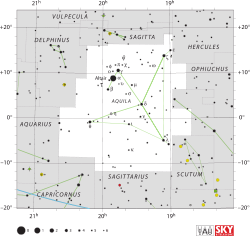Tau Aquilae

| |
| Observation data Epoch J2000.0 Equinox J2000.0 | |
|---|---|
| Constellation | Aquila |
| Right ascension | 20h 04m 08.31550s[1] |
| Declination | +07° 16′ 40.6683″[1] |
| Apparent magnitude (V) | 5.6799 ± 0.0009[2] |
| Characteristics | |
| Spectral type | K0 III[3] |
| U−B color index | +0.86[4] |
| B−V color index | +1.06[4] |
| Astrometry | |
| Radial velocity (Rv) | –29.52 ± 0.23[2] km/s |
| Proper motion (μ) | RA: +14.74[1] mas/yr Dec.: +12.10[1] mas/yr |
| Parallax (π) | 7.06 ± 0.41[1] mas |
| Distance | 460 ± 30 ly (142 ± 8 pc) |
| Details | |
| Radius | 16.5[5] R☉ |
| Surface gravity (log g) | 2.69[3] cgs |
| Temperature | 4,660[3] K |
| Metallicity [Fe/H] | –0.15[3] dex |
| Other designations | |
Tau Aquilae (τ Aql, τ Aquilae) is the Bayer designation for a star in the equatorial constellation of Aquila. The apparent visual magnitude of 5.7[2] indicates it is a faint star that is visible to the naked eye from suburban skies; at least according to the Bortle Dark-Sky Scale. The annual orbital motion of the Earth causes a parallax shift of 7.06 mas,[1] which means the distance to this star is approximately 460 light-years (140 parsecs). The magnitude of the star is diminished by 0.28 from extinction caused by interstellar gas and dust.[2]
The spectrum of Tau Aquilae matches a stellar classification of K0 III,[3] with the luminosity class of III suggesting this is an evolved giant star that has exhausted the supply of hydrogen at its core and left the main sequence of stars like the Sun. The measured angular diameter of this star is 1.08 ± 0.01 mas.[7] At the estimated distance of this system, this yields a physical size of about 16.5 times the radius of the Sun.[5] The outer envelope is radiating energy into space with an effective temperature of 4,660 K,[3] giving it the orange hued glow of a K-type star.[8]
References
- 1 2 3 4 5 6 van Leeuwen, F. (November 2007), "Validation of the new Hipparcos reduction", Astronomy and Astrophysics, 474 (2): 653–664, arXiv:0708.1752
 , Bibcode:2007A&A...474..653V, doi:10.1051/0004-6361:20078357.
, Bibcode:2007A&A...474..653V, doi:10.1051/0004-6361:20078357. - 1 2 3 4 Famaey, B.; et al. (January 2005), "Local kinematics of K and M giants from CORAVEL/Hipparcos/Tycho-2 data. Revisiting the concept of superclusters", Astronomy and Astrophysics, 430 (1): 165–186, arXiv:astro-ph/0409579
 , Bibcode:2005A&A...430..165F, doi:10.1051/0004-6361:20041272.
, Bibcode:2005A&A...430..165F, doi:10.1051/0004-6361:20041272. - 1 2 3 4 5 6 McWilliam, Andrew (December 1990), "High-resolution spectroscopic survey of 671 GK giants. I - Stellar atmosphere parameters and abundances", Astrophysical Journal Supplement Series, 74: 1075–1128, Bibcode:1990ApJS...74.1075M, doi:10.1086/191527.
- 1 2 Johnson, H. L.; et al. (1966), "UBVRIJKL photometry of the bright stars", Communications of the Lunar and Planetary Laboratory, 4 (99), Bibcode:1966CoLPL...4...99J.
- 1 2 Lang, Kenneth R. (2006), Astrophysical formulae, Astronomy and astrophysics library, 1 (3rd ed.), Birkhäuser, ISBN 3-540-29692-1. The radius (R*) is given by:
- ↑ "tau Aql -- Star", SIMBAD Astronomical Database, Centre de Données astronomiques de Strasbourg, retrieved 2012-07-21.
- ↑ Richichi, A.; Percheron, I.; Khristoforova, M. (February 2005), "CHARM2: An updated Catalog of High Angular Resolution Measurements", Astronomy and Astrophysics, 431: 773–777, Bibcode:2005A&A...431..773R, doi:10.1051/0004-6361:20042039
- ↑ "The Colour of Stars", Australia Telescope, Outreach and Education, Commonwealth Scientific and Industrial Research Organisation, December 21, 2004, retrieved 2012-01-16